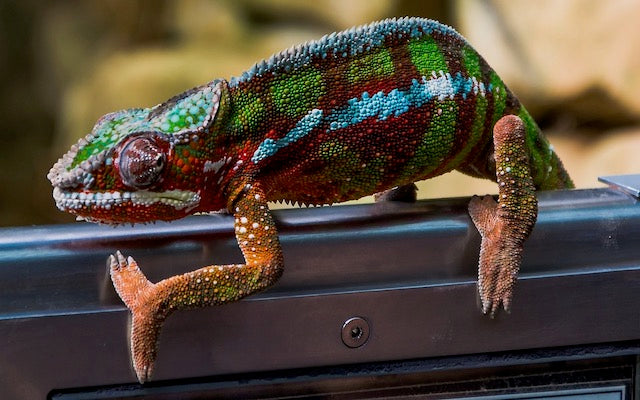When it comes to creating the ideal habitat for your pet chameleon, there’s a great deal you’ll need inside your chameleon cage. Not only will you need the chameleon cage itself, but you’ll also need lights, misters, drippers, plants, and more to create an optimized chameleon habitat.
Furnishing your chameleon cage can feel overwhelming, but don’t worry. This article will walk you through everything you’ll need for outfitting your chameleon’s enclosure and making your chameleon feel right at home.
Chameleon Cage: Purchasing Your Chameleon Enclosure
The first thing you’ll need is a chameleon cage. This might seem pretty straight forward, but you actually have several options when it comes to purchasing your chameleon cage. Each option comes with its own advantages and disadvantages.
Options include:
- A screen chameleon cage
- A glass chameleon cage
- A hybrid chameleon cage
Screen Chameleon Cage
Screen chameleon cages are readily available, and you can often purchase a complete kit that includes most of the furnishings you’ll need inside your screen chameleon cage. Screen cages are also easy to set up, allow for plenty of air circulation, and are much lighter than a glass or hybrid chameleon cage.
However, the air circulation can make it difficult to maintain optimal heat and humidity temperatures inside a screen chameleon cage.
Since temperature and humidity are central concerns for maintaining your chameleon’s health, you’ll have to make sure that the ambient temperature and humidity in the room where you keep your chameleon cage is roughly what your chameleon’s habitat needs to be.
Glass Chameleon Cage
A glass chameleon cage solves the problem of maintaining optimal heat and temperature within the enclosure by isolating the environment of the enclosure from the external environment. However, glass enclosures come with their own potential drawbacks.
The biggest problem is that it can be difficult to find a glass chameleon cage that is the right size and height for your chameleon. Chances are, you won’t find a glass chameleon cage that measures 2’ by 2’ by 4’ – the minimum enclosure measurements recommended for your chameleon cage. However, it can work better if you use a glass tank that measures 36” by 18” by 36”. This will give your chameleon plenty of space for moving and climbing.
Ventilation and drainage are also major concerns for folks who opt for a glass chameleon cage. If your chameleon’s air goes stale, you put it at risk for respiratory infections. For the most part, the opening at the top of the glass chameleon cage should provide sufficient ventilation. You may have to drill holes in the bottom of the enclosure to allow for proper drainage.
Pro Tip: If you choose to keep your chameleon in a glass enclosure, look for a tank between 100 and 120 gallons.

Hybrid Chameleon Cage
There are now hybrid chameleon cages that attempt to combine the benefits of the glass chameleon cage with the benefits of the screen chameleon cage.
These hybrid chameleon cages will often have two or three sides glass and one or two sides screen. Sometimes they may be completely glass, but have screened windows that you can open and close for ventilation.
The greatest disadvantage of a hybrid chameleon cage is that they tend to be more expensive than an all-screen or an all-glass chameleon cage.
Pro Tip: If you have an all-screen chameleon cage, you can purchase a “background” that will not only give the illusion of greater space to your enclosure, but can also be used to close off two or three sides of the enclosure. This will make it easier to maintain temperature and humidity.
Creating Your Chameleon Habitat: Furnishing Your Chameleon Cage
Once you’ve chosen the type of chameleon cage you’re going to use to create the perfect habitat for your pet chameleon, it’s time to furnish it with everything your chameleon needs. This means you’ll need:
- UVB and heat lamp fixtures
- Branches, vines, and plants
- A misting system
- A drip system
- A substrate tray
- A hygrometer and a digital thermometer
UVB and Heat Lamp Fixtures
The habitat within your chameleon cage needs to maintain a proper temperature gradient. This means maintaining ambient temperatures between 70º and 80ºF, with basking area temperatures between 85º and 90ºF.
A heat lamp with a 75-100 watt bulb should work just fine for maintaining optimal temperatures in your chameleon’s habitat.
In nature, chameleons get the bulk of their vitamin D by basking in the sunlight. Vitamin D helps them absorb the minerals and calcium from their food, thus staving off Metabolic Bone Disease (MBD). In captivity, you’ll have to recreate this environment by using a UVB lamp.
When equipping your chameleon cage with a UVB lamp and bulb, be sure to look for a T5 5.0 UVB that’s 24”-36” long. If you’ve bought a chameleon enclosure kit from a pet store, it likely doesn’t have the right kind of UVB bulbs. Thankfully 24” and 36” T5 5.0 UVB bulbs are easy to find.
Misting and Drip Systems
In order to maintain humidity levels and provide proper hydration for your chameleon, you’ll need to have some sort of misting and drip system.
Most chameleon keepers prefer to purchase an automatic misting system so they don’t have to worry about misting in the morning and in the evening. The MistKing is by far the most popular system. You can even purchase them with a built-in timer, making your life as a chameleon keeper that much easier.
Although you can also purchase a drip system, most chameleon keepers opt for a much cheaper method. Simply thoroughly clean a one-gallon milk jug, punch a small hole in the bottom corner with a pushpin, then fill the jug with water and place it on top of your chameleon cage.
Plants and Branches
As an arboreal creature, your chameleon will spend all its time climbing among the branches, vines, and plants that you supply within your chameleon cage. Most chameleon keepers use a combination of live and artificial plants, rubber vines, and wooden dowels to create climbing structures that mimic a chameleon’s natural habitat.
You can purchase artificial plants and rubber vines from crafting stores like Michaels and Hobby Lobby. Just be sure that these are non-toxic and made of plastic. Artificial plants made of fabric material end up turning into a nasty mess that you don’t want to deal with.

For live plants, you’ll want to choose plants that are safe for your chameleon. There’s a small chance your chameleon may eat a leaf or two at some point, so you want to be sure whatever plants you include won’t make it sick. Plants that are safe for chameleons include:
- Ficus
- Schefflera
- Hibiscus
- Pothos
- Jade
- Spider plant
- Weeping fig
- Filadendron
- Peace lily
For a more complete list of everything you’ll need for your chameleon keeping needs, along with price estimates, check out our article “How Much Are Chameleons?”
Takeaway: It can be overwhelming to gather together everything you’ll need to create the ideal habitat within your chameleon cage. But with a little effort and investment, you’ll be able to create an environment where your chameleon can thrive.








